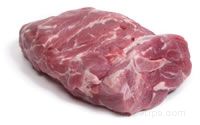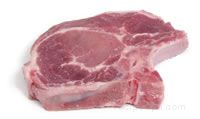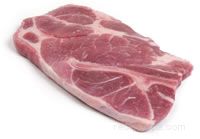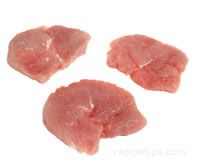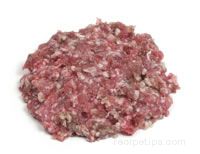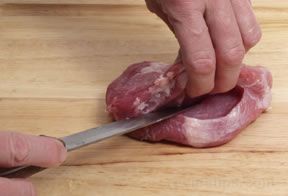|
Tips on Selecting Cuts | Terms | Description of Cuts | Inspection and Grading
Decide how much time and effort you want to use in preparing and cooking the cut you select. Chops and steaks will take less time to cook than a roast but require more attention during the cooking process.
Fresh: Meat that has not had any form of curing, smoking, salting or brining. There are many different pork retail cuts available with each having its own characteristics. Their flavor, leanness and tenderness vary according to the primal cut it is taken from and its location within the cut. To see the different cuts and a description of each, click the link below. Different cuts have several methods of cooking that are best suited to that cut. If you want to use a particular method of cooking, you will want to purchase a cut that is suited to that method. See the chart below for the suggested cuts best suited to the different cooking methods.
All retail cuts of pork have been inspected by the state or federal government. This inspection is mandatory and is performed by the Food Safety and Inspection Service of the USDA. A FSIS-USDA inspector checks the meat through all stages of processing. The inspector checks the slaughtering process, they check the carcass being cut into smaller cuts, they make sure the proper additives are added to processed meats and they make sure that all products are labeled with accurate information. All meat products, from a whole carcass to the edible byproducts must have the inspection legend seal stamped on it or shown on its label, which ensures that the meat has passed inspection for wholesomeness, disease, and that it has been processed under sanitary conditions.
Meat inspection should not be confused with grading of the meats, which refers to the quality of the meat rather than wholesomeness and safety. Grading is not mandatory and if undertaken, is paid for by the meat processor, whereas the inspection is mandatory and is a service conducted by the government that is actually paid for by the taxpayers. Pork only has two grade levels set by the USDA, which are "Acceptable" and "Utility." Acceptable, which is the only grade found in a retail store, indicates that the pork has a high ratio of lean meat to bone and fat. The utility grade, which is pork whose texture lacks firmness and contains high levels of water, is the grade used by the meat processors to make processed meat products. Reading the label will tell you much about the cut, such as the primal cut it was taken from, the name of the retail cut, the description (bone-in or boneless), the date it was packaged, total weight, cost per pound, and nutritional information. If you are familiar the different cuts, having the name of the cut on the label will help you determine if it is of the proper leanness and tenderness desired. If you are not familiar with the cuts, you will have to rely on choosing the cut by sight. The shoulder consists of cuts that contain a high level of fat, which provides flavor and tenderness. Roasting, braising and stewing are cooking methods used for these cuts. The steaks from this area are best when grilled, broiled or braised. Cuts from the loin are tender and lean. Chops from the loin are generally grilled, broiled, pan-fried or braised. The roasts are generally roasted or braised. Cuts from the leg/ham are lean but not as tender as the loin. The roasts from this cut are generally braised and the steaks are grilled, broiled, pan-fried and braised. The cuts from the side/belly are very flavorful, but contain a fair amount of fat and are generally broiled or pan-fried. Ribs are generally roasted, braised, grilled and broiled. See the chart above for cooking methods to use for different cuts. The label will contain the name of the cut and whether it is bone-in or boneless. This information will help you determine what quantity you will need to buy according to the weight contained in the package. A boneless cut will contain more servings than the bone-in cut so it is important to take this into consideration when determining your needs. A bone-in cut may be lower in cost per pound but when selecting your best value, you should compare cost per serving. To determine the cost per serving, use the following equation: Cost per pound / # of servings per pound = Cost per serving Also, consider the fact that the bone and fat, which is not edible, is what helps give your meat great flavor and tenderness, so it may be worth paying a little extra per serving for the bone-in cut.
Some pork products, such as ham, may be precooked. If so, the label will indicate that it is "fully cooked" or "ready-to-eat". If it is not, it will clearly indicate to "cook before eating". Even though the precooked hams are ready to eat, their flavor is enriched from being baked to an internal temperature of 130°F. Looking at and feeling the cut of pork can give you information that the label will not provide. When shopping for a lean cut of pork, inspect the piece to see if it is well trimmed of excess fat around the edges and that it does not have a lot of fat running through it. However, it is desirable to have some marbling running through the meat to provide added flavor and tenderness. When selecting a whole ham or shoulder a visual inspection will be difficult because you will not be able to see any of the inside area of the cut. Pork today is raised much leaner that it was years ago so it is not as much of a problem to find lean cuts. The meat of the cut you are selecting should be pink with a white to grayish tint of coloring and have a fine-grained texture. Meat from the loin is generally lighter in color than the meat from the shoulder or leg. The meat should be firm to the touch, look moist but not slimy wet, and it should not emit any foul odors. The fat on the outer edges should be creamy white and be blemish free. If the fat has a yellowish tint, it is old and probably close to being spoiled. The package the cut is contained in should be cool to the touch and free of any holes or tears. When selecting cuts such as chops and steaks, look for the individual cuts that are sliced evenly throughout, with all the cuts in a package sliced to the same thickness. This will help to ensure that each cut will cook evenly throughout and that all the cuts will finish cooking at approximately the same time. It is sometimes difficult to know just how much pork to buy to have the proper amount for a particular recipe or to serve to a specific number of people. Some of the information that will determine the quantity needed may be the type of cut you are selecting, whether the meat is bone-in or boneless, the number of people being served, whether or not it will be served in controlled portions, or if the meat will be served on a "help yourself" basis. The following information may be helpful in determining your needs.
Pork can be purchased in large quantities in several different ways, such as buying multiple retail packages, purchasing a full carcass or side of pork, or purchasing wholesale cuts. Purchasing in large quantities will generally save you money but you need to take several factors into consideration before making a purchase.
When determining your cost per pound for a full carcass, side or wholesale cut, be sure the cost for cutting, wrapping and freezing are all included. If they are not, you will have to add the costs in to get the actual price per pound to compare your cost to the cost of buying the meat as retail cuts. Also, take into consideration all of the different cuts you will get when you purchase a full carcass or side. The bacon, hams and other cuts that you want smoked or processed in a special manner will add to your cost and you will have to be sure your provider has the capability to do this processing. There may also be cuts that you will get that are not some you generally purchase. If your household will not eat these items, you will be paying for wasted cuts. This may determine whether or not it is wiser to purchase the full carcass or side, or to purchase only wholesale or retail cuts that you know your household will consume. Your butcher or retailer should complete the wrapping and freezing of the cuts because they will be equipped to do it properly. The meat must to be wrapped tightly in a moisture proof wrap to eliminate all air within the package. If air is allowed to enter, it will remove moisture from the meat, causing deterioration in quality, which will eventually cause freezer burn. The meat should be wrapped in waxed freezer paper or a heavy aluminum foil. Be sure the packages are marked with the date when they are wrapped. Make sure that your butcher or retailer is properly equipped to quick-freeze your meat after cutting and wrapping. The quick freezing process is less damaging to the meat fibers, where slow freezing may cause ice crystals to form, which can rupture the cells in the meat. This damage results in the loss of more juices when the meat is thawed and a loss of flavor when cooked. | ||||||||||||||||||||||||||||||||||||||||
Loading
Pork Shopping Guide

Provided By
RecipeTips
RecipeTips

Loading
There currently aren't any reviews or comments for this article. Be the first!
Popular Recipe Pages
Popular Recipes
Advertisement
Advertisement







